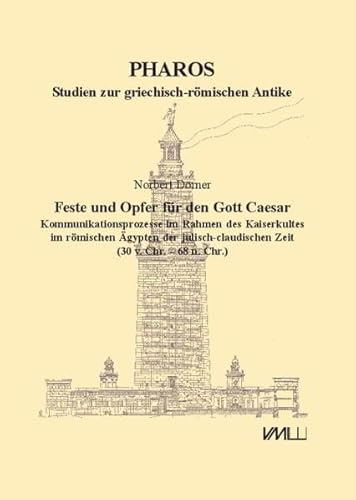Articles liés à Dörner, N: Feste und Opfer für den Gott Caesar

L'édition de cet ISBN n'est malheureusement plus disponible.
Afficher les exemplaires de cette édition ISBN- ISBN 10 3867572585
- ISBN 13 9783867572583
- ReliureRelié
Frais de port :
EUR 32,99
De Allemagne vers Etats-Unis
Meilleurs résultats de recherche sur AbeBooks
Feste und Opfer für den Gott Caesar: Kommunikationsprozesse im Rahmen des Kaiserkultes im römischen Ägypten der julisch-claudischen Zeit [30 v.Chr. - . Studien zur griechisch-römischen Antike) : Kommunikationsprozesse im Rahmen des Kaiserkultes im römischen Ägypten der julisch-claudischen Zeit [30 v.Chr. - 68 n.Chr.]
Description du livre Gebundene Ausgabe. Etat : Gebraucht. Gebraucht - Sehr gut SG - leichte Beschädigungen oder Verschmutzungen, ungelesenes Mängelexemplar, gestempelt - Die Provinz Ägypten wird weithin als ein Gebiet betrachtet, in dem der Kaiserkult aufgrund der besonderen Verwaltungsstrukturen und Gesellschaftsstrukturen und der jahrtausendealten Traditionen der ägyptischen Religion kaum Fuß fassen konnte. Als äußerer Ausdruck dieser Entwicklung gilt die Übernahme der pharaonischen Würde durch den Kaiser. Mittels einer Analyse von Kommunikationsprozessen im Ägypten der julisch-claudischen Dynastie kann die Arbeit 'Opfer für den Gott Caesar' zeigen, dass diese Sichtweise nicht der Intention der Beteiligten gerecht wird. Vielmehr erweist sich, dass der Kaiser in den Augen der römischen Verwaltung nicht zum 'römischen Pharao' wurde. Statt dessen galt der Kult in den ägyptischen Tempeln als funktionales Äquivalent des provinzialen und munizipalen Kaiserkultes, weil er die Festlichkeiten für den Kaiser in der Provinz organisierte, den Kaiser nach lokalen Traditionen ehrte und die segensreiche Bedeutung seiner Herrschaft immer neu ins Gedächtnis rief. Für den griechischsprachigen Bereich kann die Arbeit die bisher weitgehend unbekannten Vorgehensweisen bei der Einführung von Kaiserkulten in Ägypten klären. Dabei zeigt sich, dass der Kaiserkult immer einer Initiative der lokalen Eliten entsprang, die Kaiserkulte mit provinzialem und munizipalem Anspruch errichteten und dabei mit den Kaiserkulten außerhalb Ägyptens konkurrierten. Auf dieser Grundlage wird es möglich, ein neues Bild von den Strukturen und Formen des Kaiserkultes in Ägypten und seiner funktionalen Äquivalente zu zeichnen. Bemerkenswert ist, dass dabei bis in die Symbolik hinein das Bestreben zu erkennen ist, den Kaiserkult außerhalb Ägyptens zwar der Bilderwelt Ägyptens angepasst, dennoch aber inhaltlich gleichartig auf Ägypten zu übertragen./The province of Egypt is still commonly seen as an area in which the imperial cult was hardly able to establish itself at all, given the specific administrative conditions and social structures, as well as the millennia-old traditions of Egyptian religion. The adoption of the Pharaonic honours by the emperor is interpreted as the outer expression of this development. Through an analysis of communication processes in Egypt during the Julian and Claudian Dynasties, 'Sacrifices for the divine Caesar¿ can show that this view does not accurately reflect the intention of the actors involved. Rather, it becomes clear that in the eyes of the Roman administration, the emperor never became a kind of ¿Roman Pharaoh'. Instead, cults in the Egyptian temples were seen as functionally equivalent to the provincial and municipal imperial cults, since the former organised the imperial festivities in the province, honoured the emperor according to local tradition and constantly recalled to mind the beneficent importance of his rule. For the Greek-speaking area, the present work can clarify the hitherto largely unknown approaches for the introduction of imperial cults in Egypt. This shows that the imperial cult was always the result of initiatives by the local elites, who established imperial cults with provincial and municipal aspirations and thereby competed with the imperial cults outside Egypt. On this basis, it was possible to draw up a new picture of the structures and form of the imperial cult in Egypt and of its functional equivalents. It is notable that, right down to symbolism, there is a clear attempt to transfer the external imperial cult into Egypt without changing its content, albeit adapting it to Egyptian imagery. N° de réf. du vendeur INF1000555180

